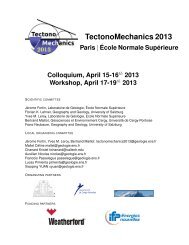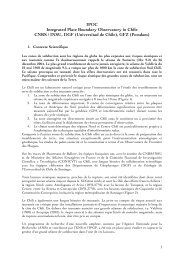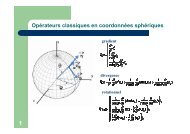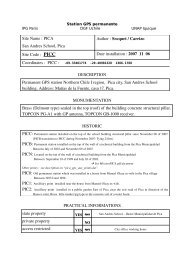PDF file - Laboratoire de Géologie de l'Ecole normale supérieure - Ens
PDF file - Laboratoire de Géologie de l'Ecole normale supérieure - Ens
PDF file - Laboratoire de Géologie de l'Ecole normale supérieure - Ens
Create successful ePaper yourself
Turn your PDF publications into a flip-book with our unique Google optimized e-Paper software.
14<br />
SOCQUET ET AL.: GPS MEASUREMENTS TO REFINE INDIA/SUNDA RELATIVE MOTION<br />
Electronic supplement to : India and Sunda Plates motion<br />
and <strong>de</strong>formation along their boundary in Myanmar<br />
<strong>de</strong>termined by GPS<br />
1. Data processing<br />
The solution presented here is a combination of two<br />
different solutions performed in<strong>de</strong>pen<strong>de</strong>ntly with<br />
different softwares (GAMIT / GLOBK and GIPSY-<br />
OASIS II). The data sets are also different, having<br />
only 60% of the sites in common, and different<br />
measurements history at some sites. The main<br />
difference in processing strategies is that GAMIT<br />
explicitly forms double differences and solves for all<br />
baselines in a given network, while GIPSY uses the<br />
precise point positioning (PPP) strategy. The second<br />
important difference is the strategy used to estimate<br />
velocities. GLOBK combines all measurements to<br />
estimate positions and velocities in an unconstrained<br />
reference frame (the so called free network solution)<br />
and map them into a given reference frame (here<br />
ITRF2000) in a second stage. GIPSY estimates<br />
positions in a given reference frame (again ITRF2000)<br />
at every epoch, and velocities are then estimated by<br />
linear trend fitting of the position time series.<br />
1.1. Details on the GAMIT/GLOBK<br />
processing<br />
The solution computed using the GAMIT /<br />
GLOBK software [Herring, 1999; King, 1999]<br />
inclu<strong>de</strong>s more than 150 stations spread over Southern<br />
Asia spanning 11 years of data processed<br />
simultaneously. The data located in SE-Asia are<br />
GEODYSSEA (GEODYnamics of South and<br />
Southeast Asia) project) (1994-1996-1998) [Michel et<br />
al., 2001], APRGP (Asia Pacific Regional Geo<strong>de</strong>tic<br />
Project) (1997-1998-1999-2000) [Govind, et al.,<br />
1999], THAICA (first or<strong>de</strong>r network of Thailand<br />
established by the Royal Thai Survey Department)<br />
(1994-1996-2000), Myanmar campaigns performed in<br />
1998-2000 [Vigny, et al., 2003] and Sulawesi<br />
(ENS/DEOS <strong>de</strong>nsification of the GEODYSSEA<br />
network in Sulawesi, Indonesia) (1999-2000-2001-<br />
2002) campaigns [Walpersdorf et al., 1999; Simons et<br />
al., 2000; Vigny et al., 2002; Socquet et al., 2005].<br />
Data located on the Indian plate inclu<strong>de</strong> the West<br />
Nepal network measured in 1991-1995-1997-1998-<br />
2000 within the CIRES and IDYLHIM projects<br />
[Bilham, et al., 1997; Larson, et al., 1999; Jouanne, et<br />
al., 1999], the Kathmandu transect measured in 1998-<br />
1999-2000 by the LDG-CEA (Commissariat à<br />
l’Energie Atomique) [Avouac, et al., 2001] and<br />
HYDE station (Hy<strong>de</strong>rabad) measured by the<br />
National Geophysical Research Institute in<br />
Hy<strong>de</strong>rabad (NGRI, India) and the Geodaetisches<br />
Institut <strong>de</strong>r Universitaet Bonn (Germany) in 1996-<br />
1997-1998-1999-2000.. Finally, all IGS stations<br />
available in the area at the time of any of our<br />
measurements are inclu<strong>de</strong>d<br />
Twenty-four-hour measurement sessions are<br />
reduced to daily positions. For every daily session<br />
theoretical values for phase and pseudorange<br />
observables are mo<strong>de</strong>lled. The mo<strong>de</strong>l parameters<br />
such as stations coordinates, phase ambiguities and<br />
tropospheric zenith <strong>de</strong>lay (one every 3 hours) are<br />
adjusted by least squares method. The observations<br />
are sampled every 30 seconds with an elevation cutoff<br />
angle of 15 <strong>de</strong>grees. We use the "LC" or "L3"<br />
Ionosphere free combination of the two-phase data<br />
and explicitly form the double differences (between<br />
every pairs of satellites and stations). During a first<br />
step the integer ambiguities are allowed to take<br />
<strong>de</strong>cimal values. They are assigned to integer values<br />
in a second step, using the method <strong>de</strong>veloped by<br />
[Dong and Bock, 1989]. We also used IGS tables<br />
for mo<strong>de</strong>lling of antenna phase centre variations.<br />
Finally, we used precise orbits from the<br />
International GPS Service for Geodynamics (IGS)<br />
[Beutler, et al., 1993] that we did not re-estimate,<br />
except for the West Nepal data of 1991 where we<br />
used the orbits computed by [Larson, et al., 1997].<br />
IGS orbits are fixed in different reference frames as<br />
time passes. This is taken into account by simply<br />
estimating the translation and rotation parameters of<br />
the reference frame at each epoch when combining<br />
the epoch solutions to estimate linear velocities at<br />
all sites. This is a standard procedure which gives<br />
similar results to the "relax" orbit kind of solutions.<br />
One of the ways to assess the internal quality of<br />
a solution is to estimate daily repeatabilities, i.e. the<br />
scatter of the baseline measurements about their<br />
campaign average. This is done for every campaign<br />
and gives a higher bound of its noise level, provi<strong>de</strong>d<br />
that sufficient repetition generates significant<br />
repeatabilities. Baseline component repeatability<br />
values for each campaign are summarized in Table<br />
S1 for fixed ambiguities. Repeatabilities vary for






